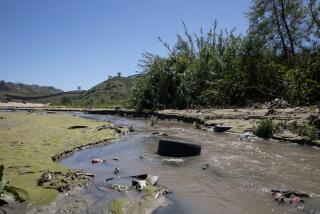The Message Is Urgent: Floodwaters Posing a Health Menace : Disease: The danger is expected to rise as people wade into waters tainted by raw sewage and pesticides to clean up their homes and businesses.
PLEASANT VALLEY, Iowa — This tiny rural hamlet now sits sunken under the murky, fetid waters of the swollen Mississippi River. Tim Shoemaker, a 25-year-old sheet metal worker, gets to and from his house by boat, navigating a tricky course past the tops of cottonwoods and maple trees and a royal blue pickup truck, submerged except for its cab.
He has weeks of cleanup ahead, and the prospect of illness is on his mind.
“There’s a guy down here, he got sick last week,” Shoemaker recalled the other day, sitting in the beat-up red vessel he usually uses to fish for bass and catfish. “He was getting out of his boat and he got wobbly and dropped some food in the water. Well, he just drained the water out of it and ate it and he had diarrhea for two days. I’ll tell you what. I won’t be touching none of this stuff.”
The tale of Shoemaker’s neighbor makes Al Moore wince. As the deputy director of the local health department, which encompasses the nearby city of Davenport, he and his counterparts throughout the flood-ravaged Midwest are working night and day to get the message out that this water is a public health menace.
And their work is only just beginning.
Although a feared outbreak of waterborne diseases has thus far failed to materialize, experts say the threat has not passed. Indeed it may increase as people wade into the waters, contaminated by raw sewage and pesticides, to clean up their homes and businesses. The assault of the raging Mississippi and its tributaries also has produced broader health concerns, for both the short and long term.
When the rivers recede, stagnant pools will become breeding grounds for mosquitoes, which carry diseases such as encephalitis, a rare but fatal brain affliction. Any outbreaks would not likely occur until September or October, after the insect larvae have had a chance to mature.
If past experience with disasters is any guide, “the acute part of the flooding isn’t really the trouble,” said Dr. Julius Conner, head of the Polk County Department of Health in Des Moines. “It’s the cleanup. This is where people are going to get injured,” she said, as was the case when Hurricane Andrew devastated South Florida last year.
Clinics and hospitals are offering free tetanus shots to protect those who suffer puncture wounds. The state shipped out 42,000 doses of vaccine to flood-stricken counties last week, and residents have been turning out in droves for the shots.
Conner’s list includes environmental hazards as well: disposal of toxic chemicals from water-soaked businesses; asbestos particles released into the air when rotted out pipes dry up; allergies flaring up from mold that grows in damp basement walls.
Mental health is going to be a big concern. Nerves are shot. People are exhausted.
In Quincy, Ill., where the last link across the Mississippi for 200 miles was closed Friday night after a levee broke on the Missouri side, psychologist Frank Froman is working with the Red Cross to set up counseling sessions.
“As levee after levee seems to collapse, and the areas that we defend get progressively smaller, people feel a greater sense of hopelessness about this,” Froman said. “The rains continue to come down every night, and there just doesn’t seem to be any respite.”
Meanwhile, the director of the U.S. Office of Emergency Preparedness has warned Iowa state officials not to underestimate the psychological fallout of the storms. During a visit last week to Des Moines, Dr. Frank E. Young, who helped supervise relief efforts after the Florida hurricane, said substance abuse, suicide attempts and domestic violence all took an upturn after that disastrous storm.
“Mental health was an area of need that we did not estimate properly,” Young said. “After the exuberance of ‘We’ve survived it,’ we saw person after person crash and burn. . . . You are just getting into the stress level. When the waters go down and people realize how ugly it is, it’s going to get worse.”
Emergency rooms--the health care system’s front line of defense--are already feeling the impact. At Des Moines General Hospital Friday morning, nurse Marilyn Conn was busy answering phones and preparing an injection of painkiller as she recounted her post-flood caseload:
“We’ve had some violence. One guy got his ear bit off--that’s not the norm. We had a little old lady in this morning, very upset, she didn’t know where to turn. She and her husband are living in their home; it’s flooded. She was complaining of back pain, but I think she just needed some TLC and some help.”
Fear of illness is running particularly high in Des Moines, where residents have been unable to bathe, flush their toilets or drink the water since last Sunday, when the Raccoon River overwhelmed a purification plant that provides water to more than 250,000 people.
The shutdown makes Des Moines the largest city in American history to lose its water supply. When the plant went out, health officials immediately ordered residents to boil the water that is being distributed at disaster relief centers, to protect against hepatitis A, dysentery and other bacterial diseases. Residents along the Mississippi, many of whom draw their water from wells that have been contaminated, must do the same.
“Boil, boil, boil,” Iowa Director of Public Health Chris Atchison has advised. The challenge now, he said, will be for residents to remain diligent about boiling once their water returns to the tap. Although the city hopes to turn the water back on within the week, it will be another month at least before the water is pure enough to drink.
Ninety miles southeast along the Des Moines River, authorities in Ottumwa are worried that they could wind up in the same boat as their big city neighbor to the north. The river level there is currently 22 feet, 12 feet above the flood danger zone, and if it overflows the Ottumwa purification plant could be knocked out, said Alan Winderes, assistant city administrator.
“The first thing we can do to protect the public health,” Winders said, “is to keep the river out.”
Back in Pleasant Valley, where 100 homes are now under water, local firefighter Gerry Ketelson can see the river’s wrath right outside his back porch. To the left are 75 year-old grapevines, turned brown from herbicides that have washed downstream. To the right is a dead pear tree, and wild horseradish, also dead.
Ketelson said he has been vaccinated for tetanus and intends to have his Artesian well disinfected and rechlorinated--even though he thinks it has probably escaped damage from the flood.
“I have seen human waste come down off our back porch,” said Ketelson, a thin bead of sweat dribbling down his nose as he took a break from cleaning up the house he has owned for 17 years. “I have seen empty beer kegs, floating refrigerators. I have seen whole trees, roots and all, and a whole lot of critters. . . . I don’t want to take any chances. Would you drink this water out here?’
More to Read
Sign up for Essential California
The most important California stories and recommendations in your inbox every morning.
You may occasionally receive promotional content from the Los Angeles Times.










